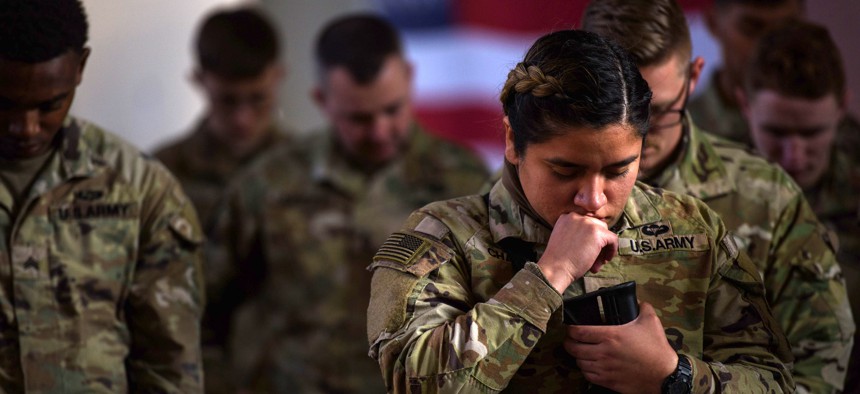No Abortion Access for 40 Percent of Female Troops, Study Finds
RAND says it’s “not unreasonable” that the lack of abortion access will make women more likely to leave service.
Because of the Supreme Court’s decision to overturn Roe v. Wade, at least 5,000 women per year working for the Defense Department are expected to face challenges when seeking abortions under new state laws, RAND analysts predicted in a paper released Wednesday, concluding that it’s “logical” to believe more women will leave the military.
The study is one of the most notable attempts yet to analyze or determine what impact the court’s decision will have on military readiness. Some Democratic advocates have called it a “matter of national security” and other veterans have encouraged women not to join the military over it. RAND analysts say women already are more likely to leave the military compared to their male colleagues, and women often say family planning around their military career and gender discrimination are the top reasons for their exit.
“It is not unreasonable to expect that both women’s propensity to serve and their subsequent retention intentions will decrease as Dobbs adds to and complicates these issues,” the paper says, referencing the Supreme Court’s decision in June to return abortion restrictions to the states in Dobbs v. Jackson Women’s Health Organization.
Since the ruling, more than one dozen states have acted to ban or severely restrict access to abortion, including several states with large military footprints such as Texas and Georgia.
RAND estimates that 450,000 active-duty troops live in a state that bans abortion or has plans to restrict access to the procedure. Of those, about 80,000 are women, though male troops who live in states with abortion bans, as well as their spouses and children, could also be affected by the state’s laws.
That means 40 percent of active-duty female troops in the continental United States “will have no or severely restricted access to abortion services where they are stationed,” the paper says.
In addition, about 275,000 civilians working for the Department of Defense live in states with abortion bans or restrictions, more than 81,000, or 30 percent, of whom are women.
RAND predicts between 5,000 and 7,400 active-duty female troops and women employeed by the Defense Department as civilians will seek an abortion each year, but will struggle to do so where they live because of the Supreme Court’s decision to overturn Roe v. Wade. Researchers estimated this statistic using the number of women in states with restricted access and the known number of troops and civilians who get an abortion each year.
Defense Department medical facilities will continue to provide limited abortions regardless of state laws, Pentagon officials have announced, but only in cases of rape, incest, or when the life of the pregnant person is at elevated risk, as required under the Hyde Amendment. Women who want abortions for any other reason but can not access them in their home state will have three choices, the paper says: request leave to travel at their own expense to a state where the procedure is legal, seek an abortion that could be unsafe in a state where it is illegal, or use pills to end a pregnancy in a state where doing so is illegal.
“If none of these options is viable to active-duty service women, they will carry their pregnancies to term in an environment where pregnancy is perceived to be stigmatized, child care is often difficult to obtain, and having a child at the wrong time could have serious implications for career trajectories,” the paper says. “All of these options have costs for DoD because they involve lost work time (from days to years), reduced health, and increased stress.”








